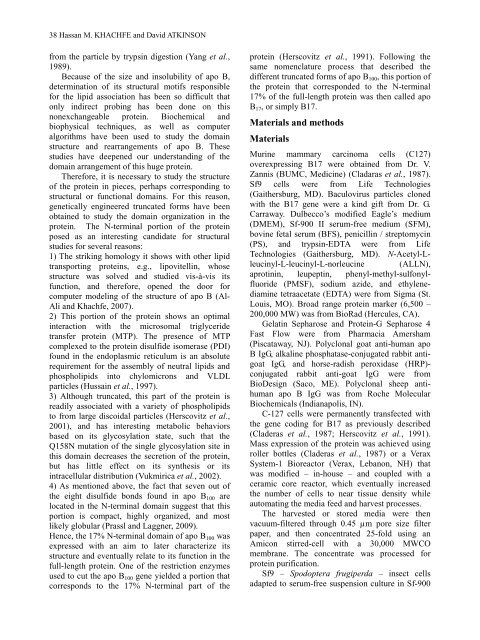Journal of Cell and Molecular Biology - ResearchGate
Journal of Cell and Molecular Biology - ResearchGate
Journal of Cell and Molecular Biology - ResearchGate
Create successful ePaper yourself
Turn your PDF publications into a flip-book with our unique Google optimized e-Paper software.
38 Hassan M. KHACHFE <strong>and</strong> David ATKINSON<br />
from the particle by trypsin digestion (Yang et al.,<br />
1989).<br />
Because <strong>of</strong> the size <strong>and</strong> insolubility <strong>of</strong> apo B,<br />
determination <strong>of</strong> its structural motifs responsible<br />
for the lipid association has been so difficult that<br />
only indirect probing has been done on this<br />
nonexchangeable protein. Biochemical <strong>and</strong><br />
biophysical techniques, as well as computer<br />
algorithms have been used to study the domain<br />
structure <strong>and</strong> rearrangements <strong>of</strong> apo B. These<br />
studies have deepened our underst<strong>and</strong>ing <strong>of</strong> the<br />
domain arrangement <strong>of</strong> this huge protein.<br />
Therefore, it is necessary to study the structure<br />
<strong>of</strong> the protein in pieces, perhaps corresponding to<br />
structural or functional domains. For this reason,<br />
genetically engineered truncated forms have been<br />
obtained to study the domain organization in the<br />
protein. The N-terminal portion <strong>of</strong> the protein<br />
posed as an interesting c<strong>and</strong>idate for structural<br />
studies for several reasons:<br />
1) The striking homology it shows with other lipid<br />
transporting proteins, e.g., lipovitellin, whose<br />
structure was solved <strong>and</strong> studied vis-à-vis its<br />
function, <strong>and</strong> therefore, opened the door for<br />
computer modeling <strong>of</strong> the structure <strong>of</strong> apo B (Al-<br />
Ali <strong>and</strong> Khachfe, 2007).<br />
2) This portion <strong>of</strong> the protein shows an optimal<br />
interaction with the microsomal triglyceride<br />
transfer protein (MTP). The presence <strong>of</strong> MTP<br />
complexed to the protein disulfide isomerase (PDI)<br />
found in the endoplasmic reticulum is an absolute<br />
requirement for the assembly <strong>of</strong> neutral lipids <strong>and</strong><br />
phospholipids into chylomicrons <strong>and</strong> VLDL<br />
particles (Hussain et al., 1997).<br />
3) Although truncated, this part <strong>of</strong> the protein is<br />
readily associated with a variety <strong>of</strong> phospholipids<br />
to from large discoidal particles (Herscovitz et al.,<br />
2001), <strong>and</strong> has interesting metabolic behaviors<br />
based on its glycosylation state, such that the<br />
Q158N mutation <strong>of</strong> the single glycosylation site in<br />
this domain decreases the secretion <strong>of</strong> the protein,<br />
but has little effect on its synthesis or its<br />
intracellular distribution (Vukmirica et al., 2002).<br />
4) As mentioned above, the fact that seven out <strong>of</strong><br />
the eight disulfide bonds found in apo B100 are<br />
located in the N-terminal domain suggest that this<br />
portion is compact, highly organized, <strong>and</strong> most<br />
likely globular (Prassl <strong>and</strong> Laggner, 2009).<br />
Hence, the 17% N-terminal domain <strong>of</strong> apo B100 was<br />
expressed with an aim to later characterize its<br />
structure <strong>and</strong> eventually relate to its function in the<br />
full-length protein. One <strong>of</strong> the restriction enzymes<br />
used to cut the apo B100 gene yielded a portion that<br />
corresponds to the 17% N-terminal part <strong>of</strong> the<br />
protein (Herscovitz et al., 1991). Following the<br />
same nomenclature process that described the<br />
different truncated forms <strong>of</strong> apo B100, this portion <strong>of</strong><br />
the protein that corresponded to the N-terminal<br />
17% <strong>of</strong> the full-length protein was then called apo<br />
B17, or simply B17.<br />
Materials <strong>and</strong> methods<br />
Materials<br />
Murine mammary carcinoma cells (C127)<br />
overexpressing B17 were obtained from Dr. V.<br />
Zannis (BUMC, Medicine) (Cladaras et al., 1987).<br />
Sf9 cells were from Life Technologies<br />
(Gaithersburg, MD). Baculovirus particles cloned<br />
with the B17 gene were a kind gift from Dr. G.<br />
Carraway. Dulbecco’s modified Eagle’s medium<br />
(DMEM), Sf-900 II serum-free medium (SFM),<br />
bovine fetal serum (BFS), penicillin / streptomycin<br />
(PS), <strong>and</strong> trypsin-EDTA were from Life<br />
Technologies (Gaithersburg, MD). N-Acetyl-Lleucinyl-L-leucinyl-L-norleucine<br />
(ALLN),<br />
aprotinin, leupeptin, phenyl-methyl-sulfonylfluoride<br />
(PMSF), sodium azide, <strong>and</strong> ethylenediamine<br />
tetraacetate (EDTA) were from Sigma (St.<br />
Louis, MO). Broad range protein marker (6,500 –<br />
200,000 MW) was from BioRad (Hercules, CA).<br />
Gelatin Sepharose <strong>and</strong> Protein-G Sepharose 4<br />
Fast Flow were from Pharmacia Amersham<br />
(Piscataway, NJ). Polyclonal goat anti-human apo<br />
B IgG, alkaline phosphatase-conjugated rabbit antigoat<br />
IgG, <strong>and</strong> horse-radish peroxidase (HRP)conjugated<br />
rabbit anti-goat IgG were from<br />
BioDesign (Saco, ME). Polyclonal sheep antihuman<br />
apo B IgG was from Roche <strong>Molecular</strong><br />
Biochemicals (Indianapolis, IN).<br />
C-127 cells were permanently transfected with<br />
the gene coding for B17 as previously described<br />
(Claderas et al., 1987; Herscovitz et al., 1991).<br />
Mass expression <strong>of</strong> the protein was achieved using<br />
roller bottles (Claderas et al., 1987) or a Verax<br />
System-1 Bioreactor (Verax, Lebanon, NH) that<br />
was modified – in-house – <strong>and</strong> coupled with a<br />
ceramic core reactor, which eventually increased<br />
the number <strong>of</strong> cells to near tissue density while<br />
automating the media feed <strong>and</strong> harvest processes.<br />
The harvested or stored media were then<br />
vacuum-filtered through 0.45 µm pore size filter<br />
paper, <strong>and</strong> then concentrated 25-fold using an<br />
Amicon stirred-cell with a 30,000 MWCO<br />
membrane. The concentrate was processed for<br />
protein purification.<br />
Sf9 – Spodoptera frugiperda – insect cells<br />
adapted to serum-free suspension culture in Sf-900

















